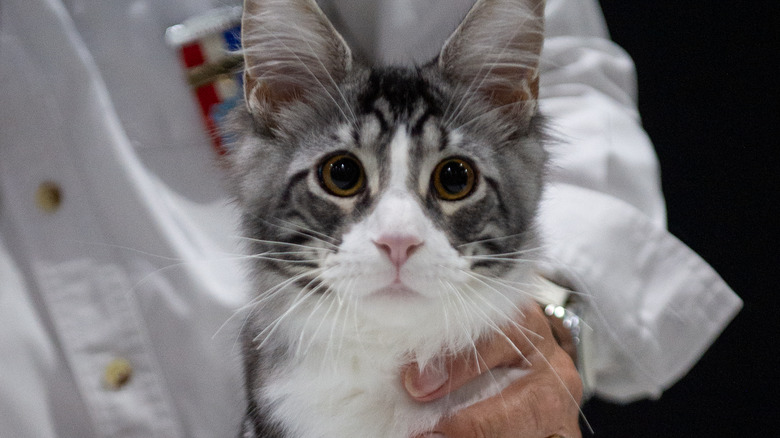What Two Princeton Scientists Learned By Turning A Living Cat Into A Phone
Let's take a minute and marvel at the astonishing evolution of the telephone over the years. The earliest model was introduced by Italian inventor Antonio Meucci in the mid-1850s, though an official patent didn't come until later on when Alexander Grahm Bell basically commandeered the innovative device and passed it off as his own, according to Open Mind BBVA. Fast-forward a few years to domestic desk top phones like the Stromberg-Carlson tapered shaft desk set, then to devices used in combat during WWI and WWII (via USMC Museum), on to the Picturephone of the 1960s, cell phones in the 90s, all the way up to the all-in-one smartphone. Seriously, it's mind-blowing to reflect on how something that was once so complex and defiant of worldly expectations can evolve into a device that fits in pockets and organizes a good part of everyday life through little apps.
As we all know, however, leaps and bounds in the technological world don't come without painstaking — and sometimes controversial — experimentation. In 1929, Professor Ernest Glen Wever and Charles William Bray, two Princeton University researchers, embarked upon a bold venture that aimed to unveil some crucial details behind sound and frequency within the telephone apparatus. While their findings were significant and pivotal, their methods were more than a little shocking. By the end of it all, the timeless expression "curiosity killed the cat" would take on an uncomfortably literal form (via Mudd Manuscript Library Blog).
Ernest Wever and Charles Bray turned a live cat into a telephone
Ernest Wever and his assistant Charles Bray started the experiment by — brace yourself — surgically opening the skull of a sedated cat and attaching a telephone wire to its cranial auditory nerve. The cable stretched an entire 50 feet and was fastened to a telephone receiver in a soundproof room away from the sleeping feline. The scene almost looked like a sick parody of science. While Bray spoke into the cat's ear at different volumes, Wever would listen closely through the receiver and record his observations as the sounds were transmitted at different frequencies (per Mudd Manuscript Library Blog).
The two researchers needed to utilize a real-life auditory nerve in order to accurately derive whatever findings would arise from the experiment. While it's certainly a barbaric and grisly thing to picture, it was far more humane (not to mention legal) to perform the exercise on an animal than on a human being. Animal rights activists might disagree, but all the same, they exhumed some interesting discoveries through their unusual tactics, as All That's Interesting points out.
What they discovered by turning a cat into a telephone
By measuring the corresponding frequencies produced by different volumes, Charles Bray and Ernest Wever more or less confirmed exactly what most scientists believed at the time: as volume increased, so did the frequency of the sound being made. After the fact, the two tried attaching the wire to different areas of the cat's body and brain. What they found was that none of the other body parts/cranial regions were able to produce the same effect, and therefore the auditory nerve was the sole facet in determining and communicating frequency and sound within the brain, according to All That's Interesting.
Afterward, Bray and Wever published "The Nature of the Acoustic Response: The Relation Between Sound Frequency and Frequency of Impulses in the Auditory Nerve," a paper that elaborately outlined what they discovered. If you're still disturbed by their Frankenstein-like experiment with the unfortunate kitty cat, find consolation in the fact that their discoveries were utilized in WWII technology and actually provided the bedrock for the first cochlear implants that are still used to assist hearing-impaired individuals today (via All That's Interesting).


